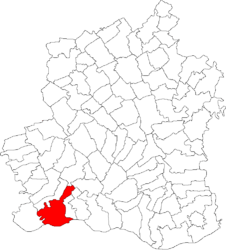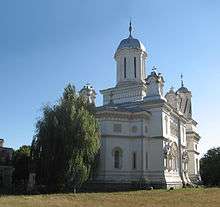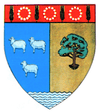Turnu Măgurele
Turnu Măgurele (Romanian pronunciation: [ˌturnu məɡuˈrele]) is a city in Teleorman County, Romania (in the historical region of Muntenia). Developed nearby the site once occupied by the medieval port of Turnu, it is situated north-east of the confluence between the Olt River and the Danube.
Turnu Măgurele | |
|---|---|
 | |
 Coat of arms | |
 Location in Teleorman County | |
 Turnu Măgurele Location in Romania | |
| Coordinates: 43°45′6″N 24°52′15″E | |
| Country | |
| County | Teleorman |
| Established | 1387 (first attested) |
| Government | |
| • Mayor | Dănuț Cuclea[1] (PSD) |
| Population (2011)[2] | 24,772 |
| Time zone | EET/EEST (UTC+2/+3) |
| Vehicle reg. | TR |
| Website | www |
Geography
A ferry plies across the Danube to the Bulgarian city of Nikopol. There are some vestiges of a Roman bridge across the Danube, built in 330 by Constantine the Great. It is built in the Danube plain in a fertile land called Burnas plain. At 4 km south-west from it the river Olt joins the Danube. Its medium altitude is 33 m above sea level.
History

The name of the city means "Hill Tower" in Romanian, in reference to the defense-wall tower of a fort built on the spot by Byzantine Emperor Justinian I in 6th century (ruins of the facilities can still be seen).
Bulgarians maintained in this place a fortress named Holavnik. The town was occupied by the Ottoman Empire in 1417, towards the end of Prince Mircea I's rule, and, like Giurgiu and Brăila, constituted a kaza on the left bank of the Danube, under the name Kule. With short interruptions during the anti-Ottoman rebellions of Vlad III the Impaler and Michael the Brave, destroyed by Iancu Jianu's hajduks in their campaign against Osman Pazvantoğlu and his successor (1809) and never rebuilt under Turkish rule, Turnu, like the other two kazas, was due to be returned to Wallachia through the 1826 Akkerman Convention - and was ultimately ceded in 1829, through the Treaty of Adrianopole. It became the capital of Teleorman County in 1839.
Towards the end of World War II, the city served as an unlikely submarine base, as Romania's two modern submarines, Rechinul and Marsuinul, took refuge in the city's port following the Soviet aerial bombardment of Constanța on 20 August 1944.[3]

The village of Islaz, near Turnu Măgurele, was the initial center of the 1848 Wallachian revolution (see Proclamation of Islaz). During the Romanian War of Independence, the town served as a base for the campaign in Bulgaria. After the administrative reform of 1968, it became a municipality. Starting with the 1960s, new apartment blocks were built in the town, however, in smaller numbers as compared to other towns and cities in the country. The newest neighborhood in the town is the Taberei housing estate, nicknamed among the locals as "Katanga", because it was built in the same time as the Katanga conflict in Congo.
Demographics
| Historical population | ||
|---|---|---|
| Year | Pop. | ±% |
| 1900 | 8,668 | — |
| 1912 | 10,169 | +17.3% |
| 1930 | 16,950 | +66.7% |
| 1948 | 11,493 | −32.2% |
| 1956 | 18,055 | +57.1% |
| 1966 | 26,409 | +46.3% |
| 1977 | 32,341 | +22.5% |
| 1992 | 36,966 | +14.3% |
| 2002 | 30,187 | −18.3% |
| 2011 | 22,268 | −26.2% |
| Source: Census data | ||
Tourist attractions
The major tourist attraction is Saint Haralambios Cathedral in the center of the town. Built by Greek farmers at the beginning of the 20th century, the cathedral is based on the plans of Curtea de Argeş Cathedral and constructed in a late renaissance style. Another city landmark is the independence monument. It was built in celebration of the major role that Turnu Măgurele played in the Romanian Independence War (1877-1878).
Economy
A chemical and textile industry (MTM, Manufactura Turnu Măgurele) center in the past, the city has more recently been diversifying its economy (ElectroTurris - an electrical engine factory, and ConservTurris - a food processing plant).
The chemical plant is notorious for the air pollution (issued gases contain ammonia and hydrogen sulfide in times above the norms), and it quite possibly does not meet the EU ecological (air pollution) requirements.[4][5]
References
- "Results of the 2016 local elections". Central Electoral Bureau. Retrieved 3 April 2020.
- "Populaţia stabilă pe judeţe, municipii, oraşe şi localităti componenete la RPL_2011" (in Romanian). National Institute of Statistics. Retrieved 4 February 2014.
- Antony Preston, Conway Maritime Press, 2001, Warship 2001-2002, p. 87
- Pollutants from large combustion plants Archived 2009-04-23 at the Wayback Machine
- Integrated pollution prevention and control
